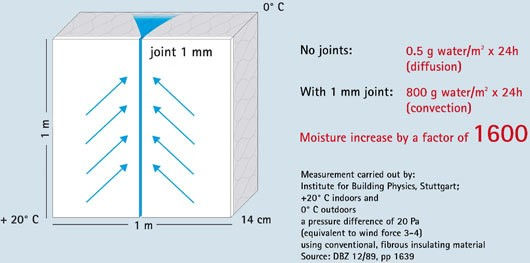AN OVERVIEW OF CONVECTION IN RELATION TO AIRTIGHT DEVELOPMENT AND BUILDING DESIGN
- Mary Bon RIBA
- Oct 12, 2015
- 4 min read
Who needs to know about convection?
All those involved in the creation of airtight building envelopes, particularly developers, professional designers and specifiers as well as contractors should be armed with some fundamental knowledge on convection. It is particularly relevant for those involved in large-scale projects where ignorance or misunderstanding on the issue could lead to repeated and costly construction errors, to the detriment of both occupant health and comfort and the environment. The purpose here is to shed light on the subject in a clear and concise manner to avoid such disastrous consequences.
What is convection and what causes it?
Differences between indoor and outdoor temperatures cause a pressure drop that creates an air current as they seek to equalize. This movement is known as convection. Convection leads to something undesirable known as ‘thermal bypass.’ More about this in a moment.
Convection is a combination of advection and diffusion. Advection is the large-scale motion of such a body in currents whereas diffusion is the small-scale movement of particles from areas of higher concentration to those of lower concentration. Diffusion will be explained more in a future post.
The cause of convection is often an inadequate airtightness layer around the building envelope, usually due to the lack of airtight detailing involving the use of joint sealing tape or expanding foam tape to close gaps.
Natural convection and forced convection

The pressure of convection on construction
Air currents can arise through either natural or forced convection.
Natural convection
Natural or ‘free’ convection results from pressure differences between one part of the building and another. Natural air movement can be either wind driven or buoyancy driven.
Wind driven air movement is caused by a difference in pressure between the inside and outside of the building caused by wind and is often referred to as ‘open loop’ convection.
Buoyancy driven air movement is caused by the tendency for warm air to expand, to become less dense and more buoyant, rising through the general air mass via the ‘stack effect.’ This is often termed ‘closed loop convection.’ Conversely cool air contracts, becoming denser, less buoyant and falling through the air mass. This creates circulating currents of rising and falling air.
Forced Convection
Forced convection occurs either where cold air moves along the surface of warmer material and at the surface the material temperature drops or where cold air penetrates the insulation, often due to poor function of the wind protection and airtightness. It can be driven by fans.
What is known as ‘wind washing’ can affect the thermal performance of low density insulation, short circuit the performance of insulating sheathing and cool down an air barrier system located towards the outside of a wall assembly, possibly below its dew point.
Thermal bypass
Air current or convection is a means of heat transportation or ‘thermal bypass’ and as warm air rises via the ‘stack effect’ it presses against a building envelope and uncontrollably escapes from it, unless both an air and wind tight building envelope is in place.
Concerns relating to ‘thermal bypass’ can have a significant influence upon the design of a residential and commercial developments.
Where can Convection processes occur?
In temperate climates, in highly insulated airtight buildings, there will be no internal draughts or convection currents. In less insulated and airtight buildings, there will inevitably be some convection as it is the result of poor jointing and inadequate sealing. If a building envelope is not airtight and lacking joint sealing tape or expanding foam tape, moist internal air can penetrate into the construction, condense and cause damage.
In hot, humid climates infiltration of humid external air can cause construction damage.
Convection can be noticeable above hot radiators where warm air rises, or next to windows where there may be a cold downdraught. These effects can be positively exploited at a larger scale in systems such as displacement ventilation, and through passive building design through the ‘stack effect’.
Convective heat transfer, or ‘thermal bypass’, typically occurs in hollow external walls, party walls and basements that are formed using multi-cell masonry and cavity construction.
Why is Convection important in airtight building envelope design?

The negative of effect of convection with a 1mm joint.
Convective air movement in buildings is important to help moderate internal temperatures, reduce the accumulation of moisture, odours and gases that build up during occupied periods and improve occupant comfort.
Research indicates that convection results in 1600 times more moisture ingress than diffusion alone.
Air tightness is not an energy saving construction ‘add-on,’ it is essential to integrate airtight design, methods and techniques to avoid construction damage. Any gaps in the external building envelope will lead to substantial damage by convection and it is reported, allow up to 40% of heating energy to be lost.
The positive benefits of convection can therefore be cancelled by its negative effects if there is a lack of airtight design.
By way of example, in developing the design for a residential development of 25 PassivHaus standard homes at the Racecourse Estate, Sunderland, concerns relating to air movement within and through walls, otherwise known as ʻthermal bypass,ʼ were deemed to have had a significant influence upon the project.
How to mitigate the negative effects of Convection and capitalise on its positive benefits:

CFP Thermogram of a non airtight building in the background and airtight passive building in the foreground
Accurately predicting the movement of air within building is possible and can require the use of computational fluid dynamics (CFD) modelling software. The software simulates the flow of air from each cell to those surrounding them and the exchange of heat between the boundary surfaces and the cells adjacent to them.
Fluids can be used to transfer heat within a building by ‘mass transfer,’ for example by the flow of a refrigerant, chilled water or hot water to provide heating or cooling.
The negative effects of convection can be also be mitigated and the positive benefits capitalised upon through rigorous airtight design as well as wind tight design. Academics conclude that all gaps and cracks should be avoided and the influence of good workmanship cannot be understated. To create the airtight building envelope vapour control layers can be applied to the warm side of the insulation and overlaps and penetrations sealed with expanding foam tape and joint sealing tape without gaps.
These techniques ensure that moisture does not remain in insulation and diminish its function, cause mould or lose heating energy to the detriment of occupants’ health and their environment.



























Comments